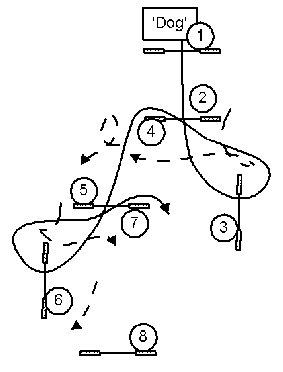Rovers Revenge!
Ever wished you dog could tell you why he took the wrong jump, or
circled the wrong way after an obstacle? This is a beginner level game. The
aim is to gain an understanding of how we communicate to our dog during a run,
and to appreciate how a dog moves.
|
The Rules: 'Dogs':
Must 'canter' with the leading leg on the side of the 'Handler' (i.e.
if Handler is standing on your left, lead with your left leg) and run
parallel with your 'handler'.
You can only change your leading leg over a jump.
If you 'land' with the wrong leading leg becasue your handler didn't cue
you to change direct, you must go in the direction of the leading leg.
(this means you will have to do a little 'circle' after the jump in the
direct on your leading leg to 'correct' yourself before heading off towards
you handler.
Keep going - anywhere. If you 'handler' isn't giving you clear signals
do which ever jump you are heading towards.
Don't say anything to your handler (other than woof)
Have fun - you're being the dog!
|
|
'Handlers':
Only verbal commands allowed are 'This way' and 'Out'.
 |
Set Up
Lay out a course with which will allow handler to direct the course using
front crosses, such as this, but put all the poles on the ground. The
jumps are closer together than normal as the human' Dogs' will be running
much slower than our cainine chums, which on a normal set up would give
the 'handler' an unrealisticly long amount of time.
Split into pairs (in class) or with a friend at home. Allocate one person
as 'A' and the other 'B'
A=Dog B=Handlers
'Dogs' Must NOT watch the round or know the course
The idea is for the 'handler' to give the 'Dog' clear signals to navigate
the course. Every time the handler uses a front cross the 'Dog' changes
leading leg to that side at the next jump.
This course gives one change of leg (cued by front cross between 4 and
5) and several opportunities to use your body movement to turn the 'Dog'.
|
The Theory
There are certain things to remember about how a dog moves.
How you direct your dog round a course affects the fluidity of his movement
and therefore his speed. Firstly , when a dog runs, it leads with either it's
left or right leg, like a cantering horse. Turning is easier when the leading
leg is on the inside.
Test this:
Do you remember pretending to ride a horse when you were a kid? Remember the
funny shuffle run you used to do, with one leg leading? First we will lead on
the Left (every stride you take you will move this leg first). Now 'canter'
round in a little Left-handed circle (with your Left leg on the inside), not
too bad was it? Now try 'cantering' a Right-handed circle, but still leading
on your Left leg. Not so good is it?!
The Point?
If you give your dog clear signals of which way he is going he can change leg
so that he is running with the correct leading leg.
Correct leg = faster turns = faster course time.
Secondly, your dog runs with you. Obvious prehaps, but lets
break it down. Your dog mainly runs parrallel to you, some dogs may be further
away, but they still run parellel unless we call them in closer, or send them
out wider. Your dog turns as you turn, in the direction you turn.
Summary:
This takes away time from running your dog in class but gives yo a great insight
to how hard it can be for the dog to know what the handler wants.
Dogs - how did you feel to have been on the receivng end of someone waving hands;
shouting 'This Way' too late, or too early; hesititing and crossing to late;
turning too early etc etc etc. After each run the 'Dog' should give feed back
to the 'handler', what did they do well from your perspective as the Dog? Which
bit's were not so good, and why?
If we think a little more about what it will take for our dog
to physically undertake the task, and what we need to do to enable that to happen
, our runs will be better.
Now move the jumps back to their normal spacing and run your real dog over through
the sequence.
© Ridinghood Pet Dog Agility Club 2002
